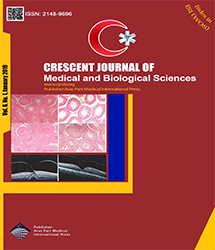
| Original Article | |
| The Relation Between the Incidence Rate of Second and Third Trimester Hemoglobin and the Incidence of Preeclampsia and Gestational Diabetes: A Cohort Study | |
| Majid Rostami Mogaddam1, Nastaran Safavi Arbedili2, Nourossadat Kariman3 | |
| 1Department of Dermatology, Ardabil University of Medical Sciences, Ardabil, Iran 2Department of Midwifery, Ardabil Branch, Islamic Azad University, Ardabil, Iran 3Midwifery and Reproductive Health Research Center, Department of Midwifery and Reproductive Health, Shahid Beheshti University of Medical Sciences, Tehran, Iran |
|
|
CJMB 2019; 6: 085-090 Viewed : 6079 times Downloaded : 3027 times. Keywords : ROC surface, Second and third trimester hemoglobin, Gestational diabetes, Preeclampsia |
|
| Full Text(PDF) | Related Articles | |
| Abstract | |
Objectives: Changes in maternal hemoglobin during pregnancy affect the incidence rate of preeclampsia and gestational diabetes mellitus (GDM). The present study aimed to investigate the relation between the second and third trimester hemoglobin and the incidence of preeclampsia and gestational diabetes. Materials and Methods: A total of 600 patients who referred to Milad hospital in 2011 participated in this study. Second and third trimester hemoglobin levels were measured. The association between the level of maternal hemoglobin and the incidence rate of preeclampsia and gestational diabetes was evaluated. In addition, the association between the second and third trimester hemoglobin level and education, job, history of abortion, as well as the use of calcium, folic acid, iron, and multivitamin pills was evaluated. Results: The results indicated that the second and third trimester maternal hemoglobin levels were high in patients with gestational diabetes and preeclampsia. Further, the relative risk of GDM was 2.12 times higher in the high hemoglobin group during the second trimester of pregnancy compared to the normal hemoglobin group (CI = 1.14-3.94) and it was 1.47 times higher in the third trimester (CI = 0.78-2.7). Furthermore, the relative risk for preeclampsia in the high hemoglobin group was 2.33 times more than normal one (CI = 1.16-4.66) and in the third trimester, it was 1.33 higher (CI = 0.66-2.66). Conclusions: The high hemoglobin, especially in the second trimester is associated with a higher risk of subsequent preeclampsia and GDM. Hence, women with high hemoglobin in their second trimester are at greater risk of developing GDM and preeclampsia. Therefore, early detection and prevention reduce undesirable effects. |
Cite By, Google Scholar
PubMed
Online Submission System
 CJMB ENDNOTE ® Style
CJMB ENDNOTE ® Style
 Tutorials
Tutorials
 Publication Charge
Medical and Biological Research Center
About Journal
Publication Charge
Medical and Biological Research Center
About Journal
Aras Part Medical International Press Editor-in-Chief
Arash Khaki
Deputy Editor
Zafer Akan


















